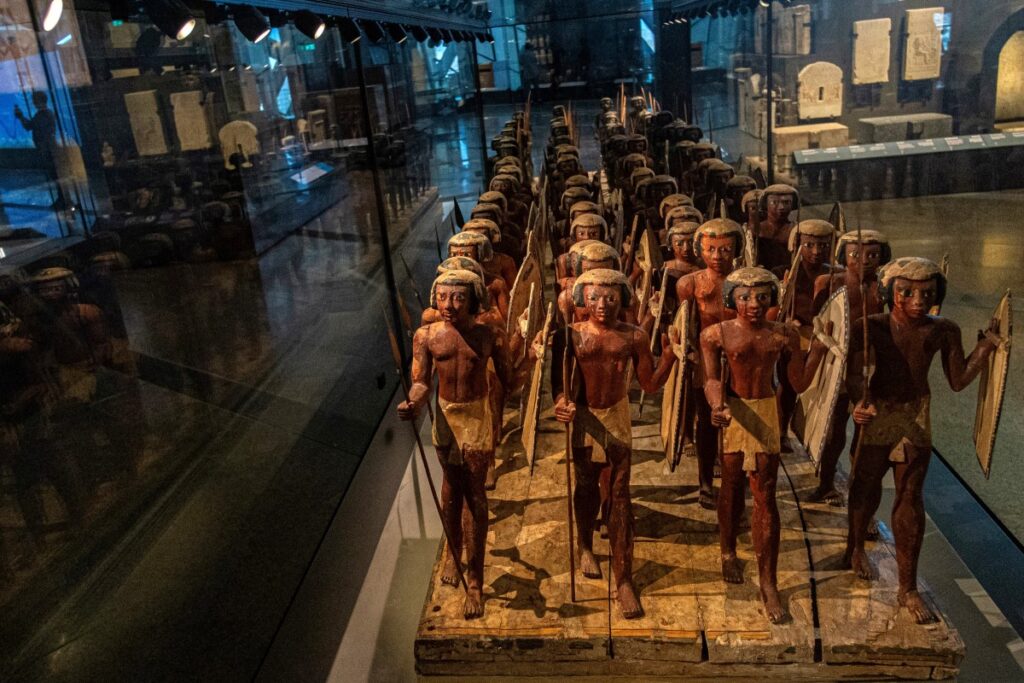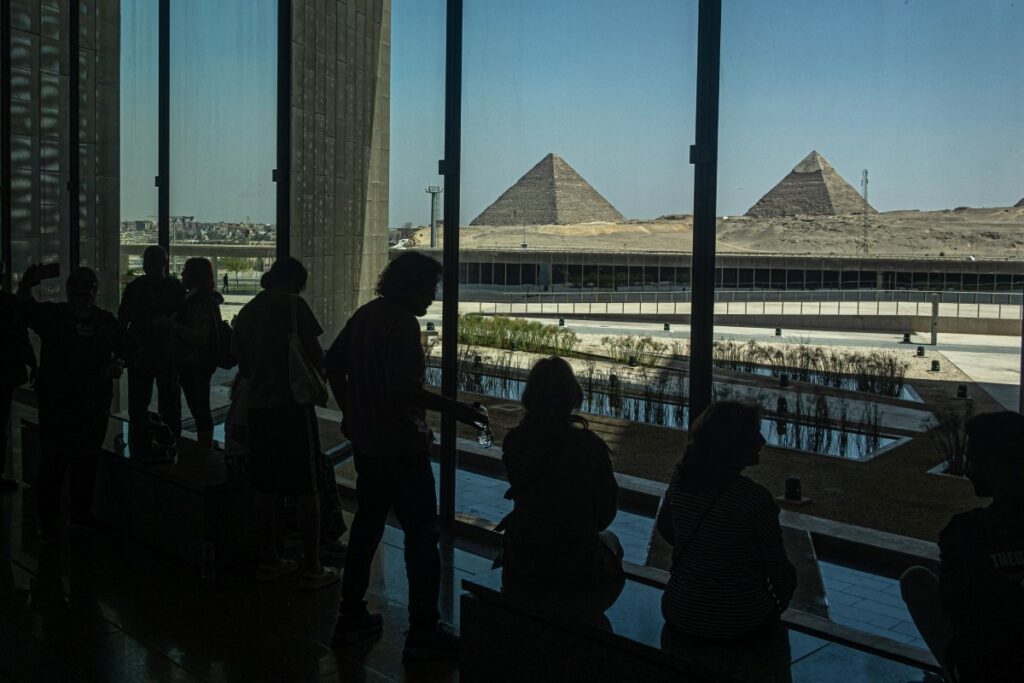With much pomp and circumstance, Cairo is today to inaugurate the long-awaited Grand Egyptian Museum, widely presented as the crowning jewel on authorities’ efforts to overhaul the country’s vital tourism industry.
With a panoramic view of the Giza pyramids plateau, the GEM houses thousands of artefacts spanning more than 5,000 years of Egyptian antiquity at a whopping cost of over $1 billion.
More than two decades in the making, the ultra-modern museum anticipates five million visitors annually, with never-before-seen relics on display.
In the run-up to the grand opening, Egyptian media and official statements have hailed the “historic moment”, describing the museum as “Egypt’s gift to the world” and a “new chapter in the history of Egyptian civilisation”.

Preparations for the much-delayed inauguration have been shrouded in secrecy.
Authorities have not named the dignitaries expected to attend, but have promised “kings, princes, heads of state and government leaders”.
Organisers have also been tight-lipped on the new display for the iconic gold mask of the boy pharaoh Tutankhamun.
Starting on November 4, the museum will be open to regular visitors who can view 4,500 of about 5,000 funerary objects previously scattered across the country, including at the colonial-era Egyptian Museum in central Cairo.
Egyptian President Abdel Fattah al-Sisi last weekend held a high-level meeting “dedicated to advancing preparations” for the inauguration, according to an official statement.
‘Symbolic dimension’
During the meeting, Sisi urged enhanced coordination to ensure the opening ceremony is held “in a manner befitting Egypt’s position, reflecting its leadership in the field of museums and global culture, and contributing to the promotion of tourism in the country”.
“Emphasis was placed on the symbolic dimension of GEM, which is set to become an international cultural and scientific hub, contributing to enhancing tourism promotion in Egypt,” the statement added.
During a final inspection visit to the site last Tuesday, Prime Minister Mostafa Madbouly said the event reflected Egypt’s role “as a cradle of civilisation and a global leader in culture and museum innovation”.
The inauguration had been set for July 3, but was postponed when Israel attacked Iran on June 13, sparking a 12-day war that closed airspace across much of the Middle East.
Even before that, the project had faced a series of setbacks, including political unrest and the impact of the COVID-19 pandemic.
In a bid to reach the widest audience possible, Egyptian state-linked conglomerate United Media Services announced a strategic partnership with TikTok seeking to “share Egypt’s unparallelled civilisational story with audiences across the globe”.
Following years of instability, Egypt’s tourism industry − which accounts for about 10% of the country’s workforce − has been recovering.
In the 2023-2024 fiscal year, tourism revenues stood at $14.4 billion, up 34.6% compared to the previous year.
Around 15 million tourists have visited Egypt in the first nine months of 2025, accounting for $12.5 billion in revenues and marking a 21% increase on the same period last year.

Five things to know about the Grand Egyptian Museum
Here are five things to know about the long-awaited museum, which Egyptian authorities have called “the largest cultural building of the 21st century”.
The Fourth Pyramid
An imitation of the nearby pyramids of Khufu, Khafre and Menkaure, the museum’s triangular glass structure was designed by the Irish firm Heneghan Peng Architects.
The state-of-the-art complex — dubbed the “fourth pyramid” of the Giza Plateau – houses around 100,000 artefacts from the 30 dynasties of ancient Egypt’s pharaohs.
About half of the collection is on display, with the rest kept in storage.
The towering $1 billion facility, which has been more than 20 years in the making, is expected to draw more than 5 million visitors every year.
The government hopes the museum will play a central role in reviving an Egyptian economy battered by debt and inflation.
Statue of Ramses II
An 11-metre granite statue of Ramses the Great greets visitors in the vast entrance atrium.
Ramses II − the third king of the 19th Dynasty − reigned more than 3,000 years ago (1279-1213 BC)and is among the greatest of all the Egyptian pharaohs.
His statue has toured the world twice, attracting millions of visitors in 1986 and then from 2021 to 2025.
The GEM will be the statue’s final home after several relocations since its discovery in 1820 near a temple in ancient Memphis, south of Cairo.
From 1954 to 2006 the statue stood in front of Cairo’s main train station.
Treasures of Tutankhamun
One gallery is dedicated to the 5,000 artefacts from the collection of King Tutankhamun, the most well-known figure of Ancient Egypt.
The full collection is in one place for the first time since British archaeologist Howard Carter discovered the famed pharaoh’s tomb in the Valley of the Kings near Luxor in 1922.
The boy king’s gold-covered sarcophagus and his burial mask, inlaid with lapis lazuli, will take centre stage at Saturday’s opening.
After years of debate, genetic tests conducted in the early 2010s suggested malaria and a bone disease led to the pharaoh’s death at the age of 19.
Solar boats
A separate building was designed for the 4,600-year-old solar boat of Pharaoh Khufu, one of the largest and oldest wooden artefacts from antiquity.
The 44-metre-long cedar and acacia wooden boat was discovered in 1954 near the Great Pyramid of Khufu − the largest of the three structures.
Over the next three years, visitors will also be able to watch experts from behind a glass wall as they restore another boat discovered in 1987.
Panorama
The museum was partially opened to the public in October 2024.
Launched in 2002 under then-President Hosni Mubarak, its grand opening was delayed by political turmoil after the 2011 uprising, the COVID-19 pandemic and regional conflicts.
The GEM is built around a colossal six-storey staircase lined with mammoth statues and ancient tombs leading to a panoramic window with a view of the nearby pyramids.
Twelve main galleries trace civilisation across 5,000 years of history, from prehistoric times to the Roman era.
The complex also includes storage areas open to researchers, laboratories and restoration workshops.










